Report: Enhancing Critical Thinking by Teaching Management Approaches
VerifiedAdded on 2021/04/17
|8
|1982
|480
Report
AI Summary
This report provides a comprehensive analysis of an article that investigates the impact of different management approaches on enhancing critical thinking skills among students. The study, conducted through a quasi-experiment involving surveys, interviews, and case analysis, compares the outcomes of students taught a conventional management approach with those exposed to both conventional and alternative approaches. The article emphasizes the importance of critical thinking, particularly in business schools, and highlights the two key dimensions of critical thinking: technical and philosophical. The research reveals that students exposed to multiple management approaches demonstrate improved critical thinking abilities, especially in the philosophical domain. The report examines the methodology, findings, and implications of the study, emphasizing the need for business schools to integrate both technical and philosophical dimensions to foster enhanced critical thinking among students, ultimately preparing them for effective management roles. The study's findings suggest that a shift towards incorporating diverse management perspectives can significantly improve students' ability to analyze complex situations, make informed decisions, and apply critical thinking in practical scenarios.
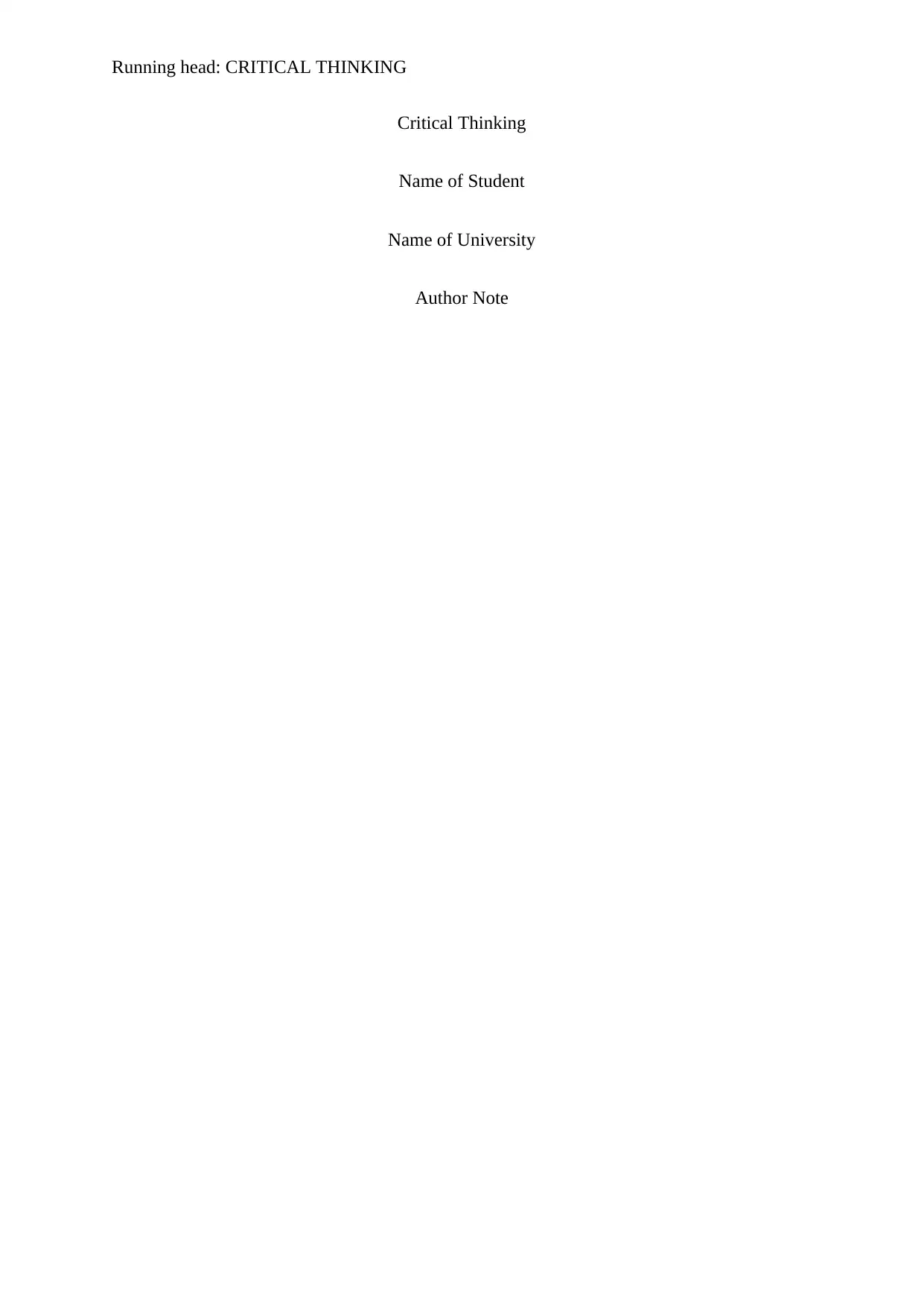
Running head: CRITICAL THINKING
Critical Thinking
Name of Student
Name of University
Author Note
Critical Thinking
Name of Student
Name of University
Author Note
Paraphrase This Document
Need a fresh take? Get an instant paraphrase of this document with our AI Paraphraser
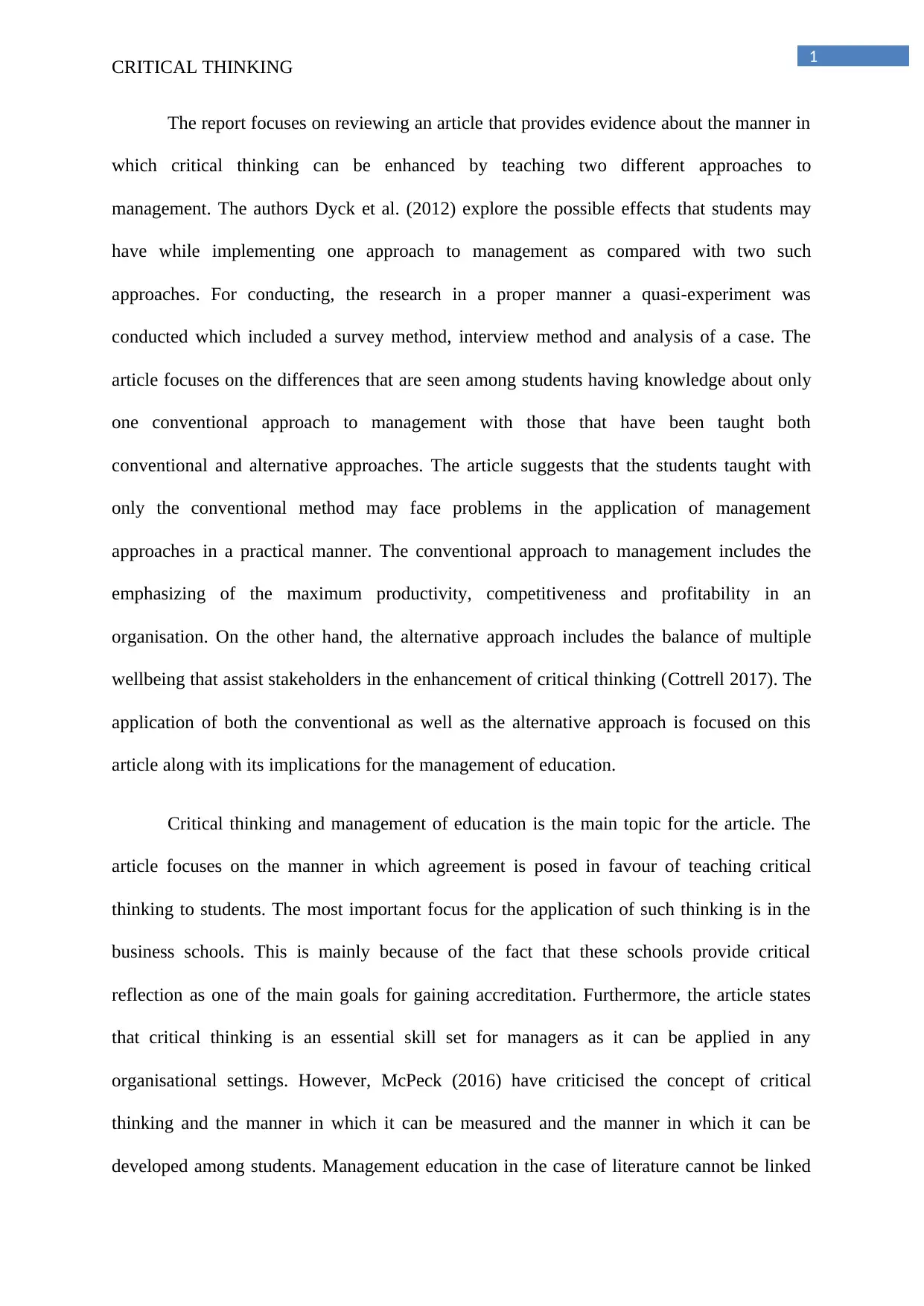
1
CRITICAL THINKING
The report focuses on reviewing an article that provides evidence about the manner in
which critical thinking can be enhanced by teaching two different approaches to
management. The authors Dyck et al. (2012) explore the possible effects that students may
have while implementing one approach to management as compared with two such
approaches. For conducting, the research in a proper manner a quasi-experiment was
conducted which included a survey method, interview method and analysis of a case. The
article focuses on the differences that are seen among students having knowledge about only
one conventional approach to management with those that have been taught both
conventional and alternative approaches. The article suggests that the students taught with
only the conventional method may face problems in the application of management
approaches in a practical manner. The conventional approach to management includes the
emphasizing of the maximum productivity, competitiveness and profitability in an
organisation. On the other hand, the alternative approach includes the balance of multiple
wellbeing that assist stakeholders in the enhancement of critical thinking (Cottrell 2017). The
application of both the conventional as well as the alternative approach is focused on this
article along with its implications for the management of education.
Critical thinking and management of education is the main topic for the article. The
article focuses on the manner in which agreement is posed in favour of teaching critical
thinking to students. The most important focus for the application of such thinking is in the
business schools. This is mainly because of the fact that these schools provide critical
reflection as one of the main goals for gaining accreditation. Furthermore, the article states
that critical thinking is an essential skill set for managers as it can be applied in any
organisational settings. However, McPeck (2016) have criticised the concept of critical
thinking and the manner in which it can be measured and the manner in which it can be
developed among students. Management education in the case of literature cannot be linked
CRITICAL THINKING
The report focuses on reviewing an article that provides evidence about the manner in
which critical thinking can be enhanced by teaching two different approaches to
management. The authors Dyck et al. (2012) explore the possible effects that students may
have while implementing one approach to management as compared with two such
approaches. For conducting, the research in a proper manner a quasi-experiment was
conducted which included a survey method, interview method and analysis of a case. The
article focuses on the differences that are seen among students having knowledge about only
one conventional approach to management with those that have been taught both
conventional and alternative approaches. The article suggests that the students taught with
only the conventional method may face problems in the application of management
approaches in a practical manner. The conventional approach to management includes the
emphasizing of the maximum productivity, competitiveness and profitability in an
organisation. On the other hand, the alternative approach includes the balance of multiple
wellbeing that assist stakeholders in the enhancement of critical thinking (Cottrell 2017). The
application of both the conventional as well as the alternative approach is focused on this
article along with its implications for the management of education.
Critical thinking and management of education is the main topic for the article. The
article focuses on the manner in which agreement is posed in favour of teaching critical
thinking to students. The most important focus for the application of such thinking is in the
business schools. This is mainly because of the fact that these schools provide critical
reflection as one of the main goals for gaining accreditation. Furthermore, the article states
that critical thinking is an essential skill set for managers as it can be applied in any
organisational settings. However, McPeck (2016) have criticised the concept of critical
thinking and the manner in which it can be measured and the manner in which it can be
developed among students. Management education in the case of literature cannot be linked
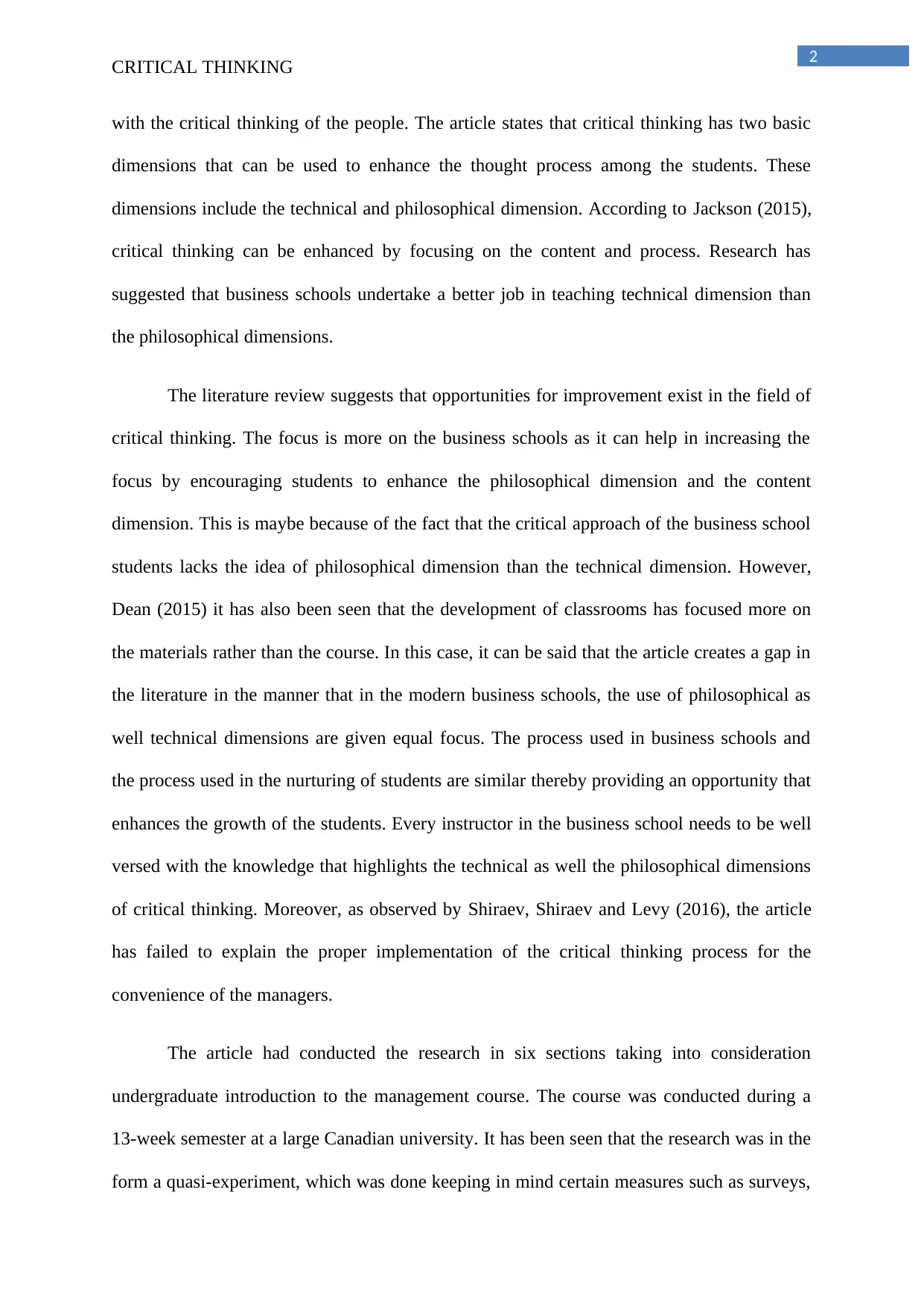
2
CRITICAL THINKING
with the critical thinking of the people. The article states that critical thinking has two basic
dimensions that can be used to enhance the thought process among the students. These
dimensions include the technical and philosophical dimension. According to Jackson (2015),
critical thinking can be enhanced by focusing on the content and process. Research has
suggested that business schools undertake a better job in teaching technical dimension than
the philosophical dimensions.
The literature review suggests that opportunities for improvement exist in the field of
critical thinking. The focus is more on the business schools as it can help in increasing the
focus by encouraging students to enhance the philosophical dimension and the content
dimension. This is maybe because of the fact that the critical approach of the business school
students lacks the idea of philosophical dimension than the technical dimension. However,
Dean (2015) it has also been seen that the development of classrooms has focused more on
the materials rather than the course. In this case, it can be said that the article creates a gap in
the literature in the manner that in the modern business schools, the use of philosophical as
well technical dimensions are given equal focus. The process used in business schools and
the process used in the nurturing of students are similar thereby providing an opportunity that
enhances the growth of the students. Every instructor in the business school needs to be well
versed with the knowledge that highlights the technical as well the philosophical dimensions
of critical thinking. Moreover, as observed by Shiraev, Shiraev and Levy (2016), the article
has failed to explain the proper implementation of the critical thinking process for the
convenience of the managers.
The article had conducted the research in six sections taking into consideration
undergraduate introduction to the management course. The course was conducted during a
13-week semester at a large Canadian university. It has been seen that the research was in the
form a quasi-experiment, which was done keeping in mind certain measures such as surveys,
CRITICAL THINKING
with the critical thinking of the people. The article states that critical thinking has two basic
dimensions that can be used to enhance the thought process among the students. These
dimensions include the technical and philosophical dimension. According to Jackson (2015),
critical thinking can be enhanced by focusing on the content and process. Research has
suggested that business schools undertake a better job in teaching technical dimension than
the philosophical dimensions.
The literature review suggests that opportunities for improvement exist in the field of
critical thinking. The focus is more on the business schools as it can help in increasing the
focus by encouraging students to enhance the philosophical dimension and the content
dimension. This is maybe because of the fact that the critical approach of the business school
students lacks the idea of philosophical dimension than the technical dimension. However,
Dean (2015) it has also been seen that the development of classrooms has focused more on
the materials rather than the course. In this case, it can be said that the article creates a gap in
the literature in the manner that in the modern business schools, the use of philosophical as
well technical dimensions are given equal focus. The process used in business schools and
the process used in the nurturing of students are similar thereby providing an opportunity that
enhances the growth of the students. Every instructor in the business school needs to be well
versed with the knowledge that highlights the technical as well the philosophical dimensions
of critical thinking. Moreover, as observed by Shiraev, Shiraev and Levy (2016), the article
has failed to explain the proper implementation of the critical thinking process for the
convenience of the managers.
The article had conducted the research in six sections taking into consideration
undergraduate introduction to the management course. The course was conducted during a
13-week semester at a large Canadian university. It has been seen that the research was in the
form a quasi-experiment, which was done keeping in mind certain measures such as surveys,
⊘ This is a preview!⊘
Do you want full access?
Subscribe today to unlock all pages.

Trusted by 1+ million students worldwide
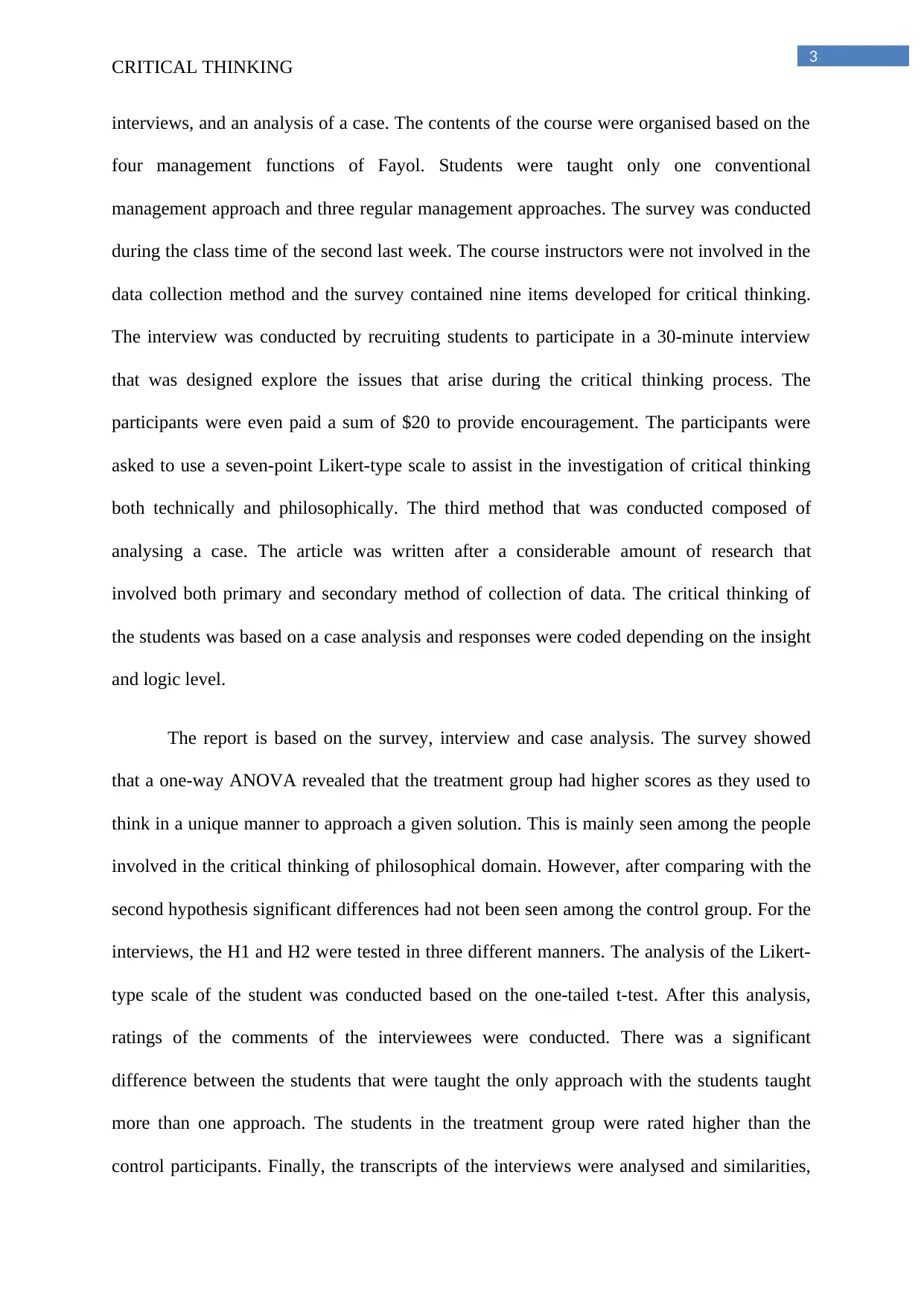
3
CRITICAL THINKING
interviews, and an analysis of a case. The contents of the course were organised based on the
four management functions of Fayol. Students were taught only one conventional
management approach and three regular management approaches. The survey was conducted
during the class time of the second last week. The course instructors were not involved in the
data collection method and the survey contained nine items developed for critical thinking.
The interview was conducted by recruiting students to participate in a 30-minute interview
that was designed explore the issues that arise during the critical thinking process. The
participants were even paid a sum of $20 to provide encouragement. The participants were
asked to use a seven-point Likert-type scale to assist in the investigation of critical thinking
both technically and philosophically. The third method that was conducted composed of
analysing a case. The article was written after a considerable amount of research that
involved both primary and secondary method of collection of data. The critical thinking of
the students was based on a case analysis and responses were coded depending on the insight
and logic level.
The report is based on the survey, interview and case analysis. The survey showed
that a one-way ANOVA revealed that the treatment group had higher scores as they used to
think in a unique manner to approach a given solution. This is mainly seen among the people
involved in the critical thinking of philosophical domain. However, after comparing with the
second hypothesis significant differences had not been seen among the control group. For the
interviews, the H1 and H2 were tested in three different manners. The analysis of the Likert-
type scale of the student was conducted based on the one-tailed t-test. After this analysis,
ratings of the comments of the interviewees were conducted. There was a significant
difference between the students that were taught the only approach with the students taught
more than one approach. The students in the treatment group were rated higher than the
control participants. Finally, the transcripts of the interviews were analysed and similarities,
CRITICAL THINKING
interviews, and an analysis of a case. The contents of the course were organised based on the
four management functions of Fayol. Students were taught only one conventional
management approach and three regular management approaches. The survey was conducted
during the class time of the second last week. The course instructors were not involved in the
data collection method and the survey contained nine items developed for critical thinking.
The interview was conducted by recruiting students to participate in a 30-minute interview
that was designed explore the issues that arise during the critical thinking process. The
participants were even paid a sum of $20 to provide encouragement. The participants were
asked to use a seven-point Likert-type scale to assist in the investigation of critical thinking
both technically and philosophically. The third method that was conducted composed of
analysing a case. The article was written after a considerable amount of research that
involved both primary and secondary method of collection of data. The critical thinking of
the students was based on a case analysis and responses were coded depending on the insight
and logic level.
The report is based on the survey, interview and case analysis. The survey showed
that a one-way ANOVA revealed that the treatment group had higher scores as they used to
think in a unique manner to approach a given solution. This is mainly seen among the people
involved in the critical thinking of philosophical domain. However, after comparing with the
second hypothesis significant differences had not been seen among the control group. For the
interviews, the H1 and H2 were tested in three different manners. The analysis of the Likert-
type scale of the student was conducted based on the one-tailed t-test. After this analysis,
ratings of the comments of the interviewees were conducted. There was a significant
difference between the students that were taught the only approach with the students taught
more than one approach. The students in the treatment group were rated higher than the
control participants. Finally, the transcripts of the interviews were analysed and similarities,
Paraphrase This Document
Need a fresh take? Get an instant paraphrase of this document with our AI Paraphraser
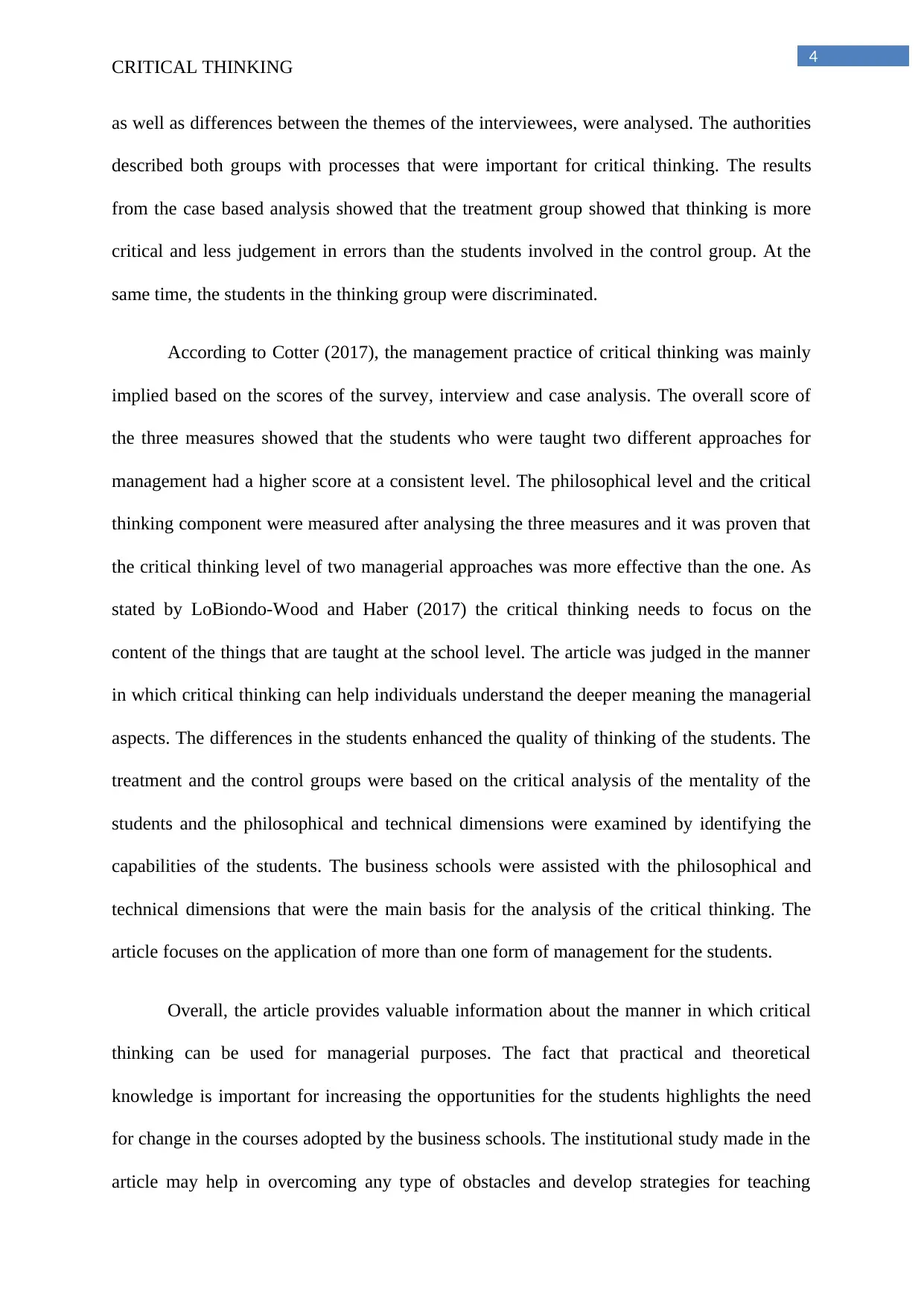
4
CRITICAL THINKING
as well as differences between the themes of the interviewees, were analysed. The authorities
described both groups with processes that were important for critical thinking. The results
from the case based analysis showed that the treatment group showed that thinking is more
critical and less judgement in errors than the students involved in the control group. At the
same time, the students in the thinking group were discriminated.
According to Cotter (2017), the management practice of critical thinking was mainly
implied based on the scores of the survey, interview and case analysis. The overall score of
the three measures showed that the students who were taught two different approaches for
management had a higher score at a consistent level. The philosophical level and the critical
thinking component were measured after analysing the three measures and it was proven that
the critical thinking level of two managerial approaches was more effective than the one. As
stated by LoBiondo-Wood and Haber (2017) the critical thinking needs to focus on the
content of the things that are taught at the school level. The article was judged in the manner
in which critical thinking can help individuals understand the deeper meaning the managerial
aspects. The differences in the students enhanced the quality of thinking of the students. The
treatment and the control groups were based on the critical analysis of the mentality of the
students and the philosophical and technical dimensions were examined by identifying the
capabilities of the students. The business schools were assisted with the philosophical and
technical dimensions that were the main basis for the analysis of the critical thinking. The
article focuses on the application of more than one form of management for the students.
Overall, the article provides valuable information about the manner in which critical
thinking can be used for managerial purposes. The fact that practical and theoretical
knowledge is important for increasing the opportunities for the students highlights the need
for change in the courses adopted by the business schools. The institutional study made in the
article may help in overcoming any type of obstacles and develop strategies for teaching
CRITICAL THINKING
as well as differences between the themes of the interviewees, were analysed. The authorities
described both groups with processes that were important for critical thinking. The results
from the case based analysis showed that the treatment group showed that thinking is more
critical and less judgement in errors than the students involved in the control group. At the
same time, the students in the thinking group were discriminated.
According to Cotter (2017), the management practice of critical thinking was mainly
implied based on the scores of the survey, interview and case analysis. The overall score of
the three measures showed that the students who were taught two different approaches for
management had a higher score at a consistent level. The philosophical level and the critical
thinking component were measured after analysing the three measures and it was proven that
the critical thinking level of two managerial approaches was more effective than the one. As
stated by LoBiondo-Wood and Haber (2017) the critical thinking needs to focus on the
content of the things that are taught at the school level. The article was judged in the manner
in which critical thinking can help individuals understand the deeper meaning the managerial
aspects. The differences in the students enhanced the quality of thinking of the students. The
treatment and the control groups were based on the critical analysis of the mentality of the
students and the philosophical and technical dimensions were examined by identifying the
capabilities of the students. The business schools were assisted with the philosophical and
technical dimensions that were the main basis for the analysis of the critical thinking. The
article focuses on the application of more than one form of management for the students.
Overall, the article provides valuable information about the manner in which critical
thinking can be used for managerial purposes. The fact that practical and theoretical
knowledge is important for increasing the opportunities for the students highlights the need
for change in the courses adopted by the business schools. The institutional study made in the
article may help in overcoming any type of obstacles and develop strategies for teaching
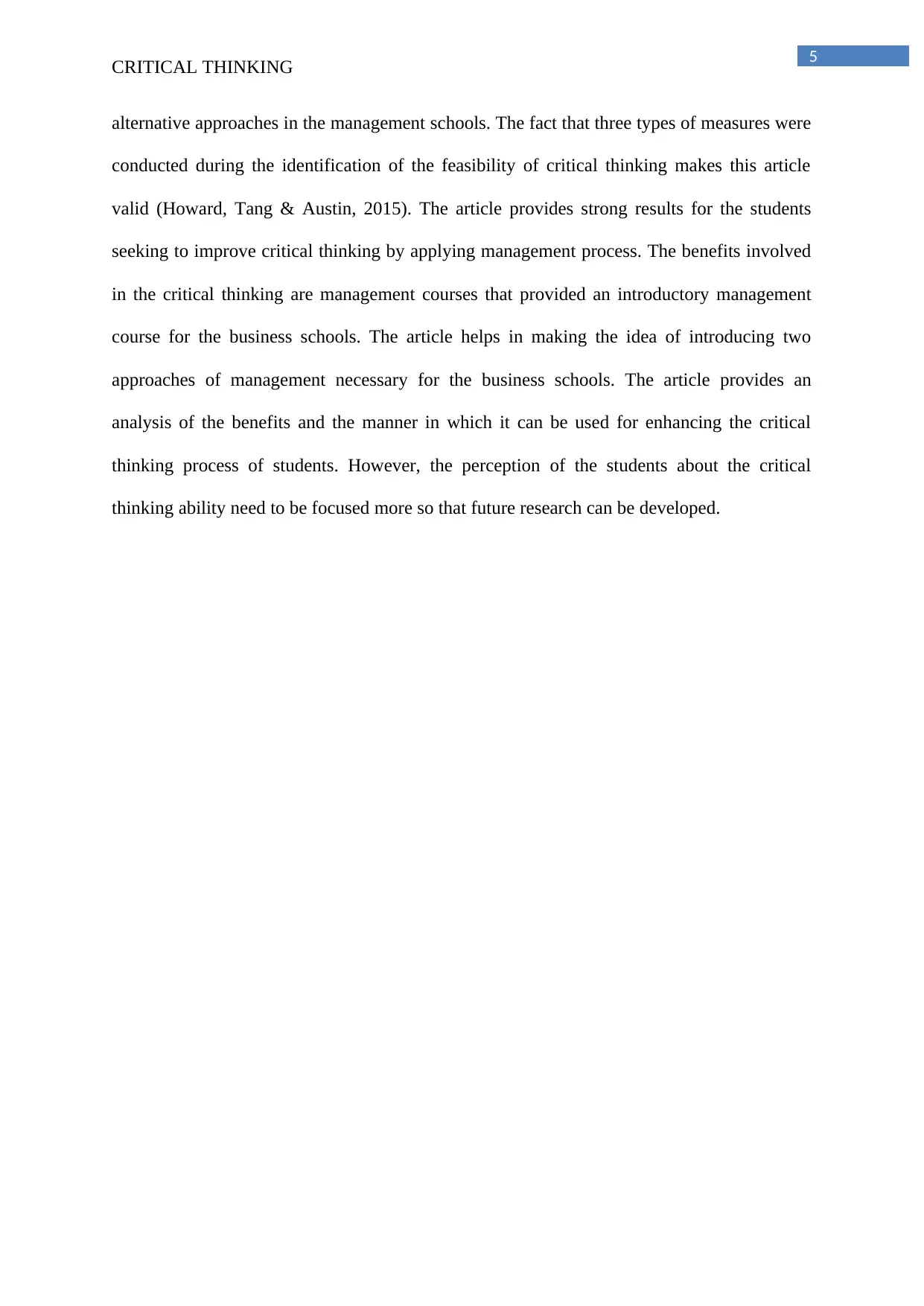
5
CRITICAL THINKING
alternative approaches in the management schools. The fact that three types of measures were
conducted during the identification of the feasibility of critical thinking makes this article
valid (Howard, Tang & Austin, 2015). The article provides strong results for the students
seeking to improve critical thinking by applying management process. The benefits involved
in the critical thinking are management courses that provided an introductory management
course for the business schools. The article helps in making the idea of introducing two
approaches of management necessary for the business schools. The article provides an
analysis of the benefits and the manner in which it can be used for enhancing the critical
thinking process of students. However, the perception of the students about the critical
thinking ability need to be focused more so that future research can be developed.
CRITICAL THINKING
alternative approaches in the management schools. The fact that three types of measures were
conducted during the identification of the feasibility of critical thinking makes this article
valid (Howard, Tang & Austin, 2015). The article provides strong results for the students
seeking to improve critical thinking by applying management process. The benefits involved
in the critical thinking are management courses that provided an introductory management
course for the business schools. The article helps in making the idea of introducing two
approaches of management necessary for the business schools. The article provides an
analysis of the benefits and the manner in which it can be used for enhancing the critical
thinking process of students. However, the perception of the students about the critical
thinking ability need to be focused more so that future research can be developed.
⊘ This is a preview!⊘
Do you want full access?
Subscribe today to unlock all pages.

Trusted by 1+ million students worldwide
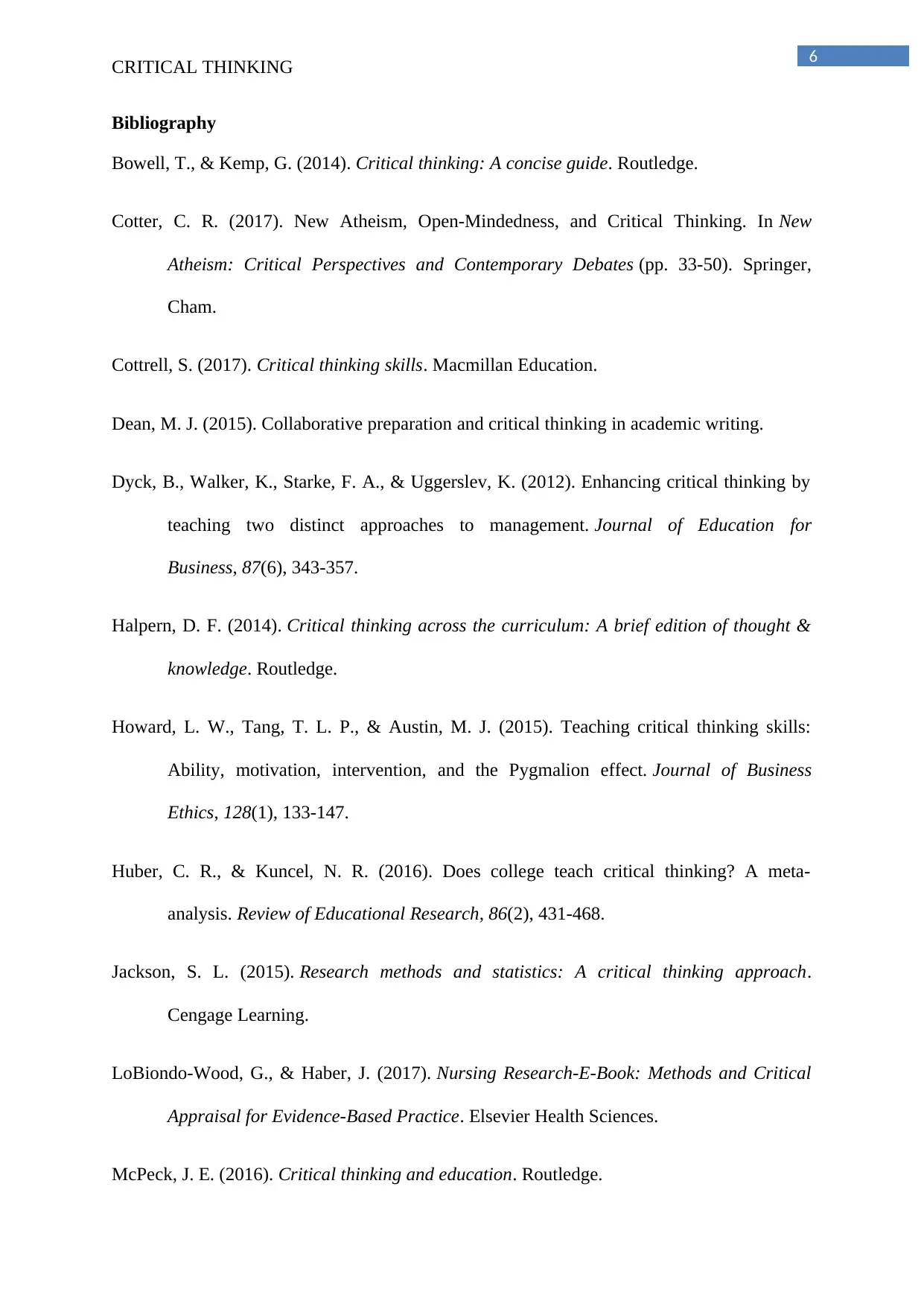
6
CRITICAL THINKING
Bibliography
Bowell, T., & Kemp, G. (2014). Critical thinking: A concise guide. Routledge.
Cotter, C. R. (2017). New Atheism, Open-Mindedness, and Critical Thinking. In New
Atheism: Critical Perspectives and Contemporary Debates (pp. 33-50). Springer,
Cham.
Cottrell, S. (2017). Critical thinking skills. Macmillan Education.
Dean, M. J. (2015). Collaborative preparation and critical thinking in academic writing.
Dyck, B., Walker, K., Starke, F. A., & Uggerslev, K. (2012). Enhancing critical thinking by
teaching two distinct approaches to management. Journal of Education for
Business, 87(6), 343-357.
Halpern, D. F. (2014). Critical thinking across the curriculum: A brief edition of thought &
knowledge. Routledge.
Howard, L. W., Tang, T. L. P., & Austin, M. J. (2015). Teaching critical thinking skills:
Ability, motivation, intervention, and the Pygmalion effect. Journal of Business
Ethics, 128(1), 133-147.
Huber, C. R., & Kuncel, N. R. (2016). Does college teach critical thinking? A meta-
analysis. Review of Educational Research, 86(2), 431-468.
Jackson, S. L. (2015). Research methods and statistics: A critical thinking approach.
Cengage Learning.
LoBiondo-Wood, G., & Haber, J. (2017). Nursing Research-E-Book: Methods and Critical
Appraisal for Evidence-Based Practice. Elsevier Health Sciences.
McPeck, J. E. (2016). Critical thinking and education. Routledge.
CRITICAL THINKING
Bibliography
Bowell, T., & Kemp, G. (2014). Critical thinking: A concise guide. Routledge.
Cotter, C. R. (2017). New Atheism, Open-Mindedness, and Critical Thinking. In New
Atheism: Critical Perspectives and Contemporary Debates (pp. 33-50). Springer,
Cham.
Cottrell, S. (2017). Critical thinking skills. Macmillan Education.
Dean, M. J. (2015). Collaborative preparation and critical thinking in academic writing.
Dyck, B., Walker, K., Starke, F. A., & Uggerslev, K. (2012). Enhancing critical thinking by
teaching two distinct approaches to management. Journal of Education for
Business, 87(6), 343-357.
Halpern, D. F. (2014). Critical thinking across the curriculum: A brief edition of thought &
knowledge. Routledge.
Howard, L. W., Tang, T. L. P., & Austin, M. J. (2015). Teaching critical thinking skills:
Ability, motivation, intervention, and the Pygmalion effect. Journal of Business
Ethics, 128(1), 133-147.
Huber, C. R., & Kuncel, N. R. (2016). Does college teach critical thinking? A meta-
analysis. Review of Educational Research, 86(2), 431-468.
Jackson, S. L. (2015). Research methods and statistics: A critical thinking approach.
Cengage Learning.
LoBiondo-Wood, G., & Haber, J. (2017). Nursing Research-E-Book: Methods and Critical
Appraisal for Evidence-Based Practice. Elsevier Health Sciences.
McPeck, J. E. (2016). Critical thinking and education. Routledge.
Paraphrase This Document
Need a fresh take? Get an instant paraphrase of this document with our AI Paraphraser
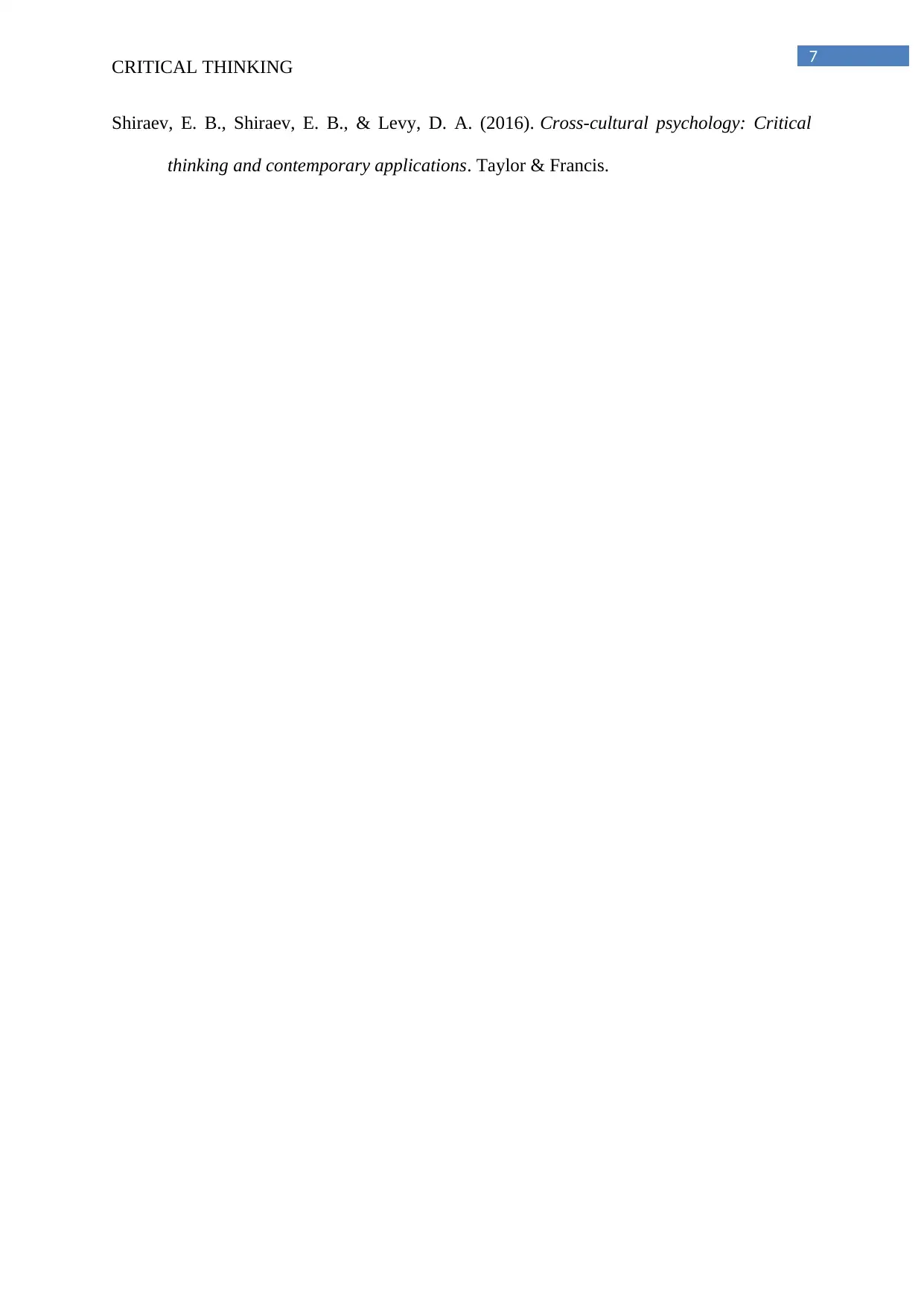
7
CRITICAL THINKING
Shiraev, E. B., Shiraev, E. B., & Levy, D. A. (2016). Cross-cultural psychology: Critical
thinking and contemporary applications. Taylor & Francis.
CRITICAL THINKING
Shiraev, E. B., Shiraev, E. B., & Levy, D. A. (2016). Cross-cultural psychology: Critical
thinking and contemporary applications. Taylor & Francis.
1 out of 8
Related Documents
Your All-in-One AI-Powered Toolkit for Academic Success.
+13062052269
info@desklib.com
Available 24*7 on WhatsApp / Email
![[object Object]](/_next/static/media/star-bottom.7253800d.svg)
Unlock your academic potential
Copyright © 2020–2025 A2Z Services. All Rights Reserved. Developed and managed by ZUCOL.





